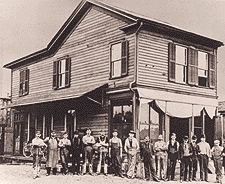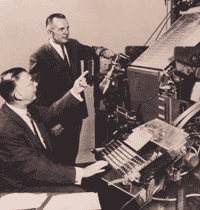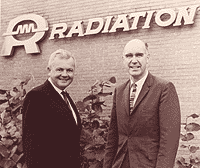Although the brothers agreed they would not get involved with any more inventions, in 1890 they were once again tinkering with an automatic sheet feeder that would eliminate the laborious job of hand-feeding printing presses. They soon began to develop a new printing press that was better able to handle their automatic feeder.
 The company's first plant was two rooms in this old house in Niles, Ohio, where President William McKinley was born. |
Their first press was a revolutionary breakthrough, delivering ten times what a pressman could feed by hand. The press was so much faster than anything available that the brothers had to understate significantly the capabilities of the press in order to get potential customers to believe them.
The Harris Automatic Press Company was responsible for many printing innovations during the early 1900s including the first commercially successful offset lithographic press and the first two-color offset press. The company made several key acquisitions in addition to strong internal growth during the first half of the century and became one of the world抯 largest and most successful manufacturers of printing equipment.
In 1957 Harris-Seybold merged with Intertype Corporation, a world leader in typesetting equipment. The resulting Harris-Intertype Corporation would be responsible for many subsequent innovations in the typesetting industry.
 Harry Porter (left), head of sales, and George Dively, general manager of Harris-Seybold, inspect an Intertype Corporation typesetting machine. Harris-Intertype Corporation was formed by merger on June 27, 1957 |
Radiation Inc. was the foundation for Harris?current Government Communications Systems business and the company抯 former Semiconductor business. The company had started in 1950 with four employees in a small two-story building located at the former Naval Air Station on the site of what is now the Melbourne International Airport.
Radiation quickly became a premier developer of miniaturized electronic tracking and pulse code technologies for America抯 new space program. Radiation抯 products were used on America抯 first communication and weather satellites and by the military for the Minuteman, Atlas, and Polaris missile systems.
Electronics from Radiation also were instrumental in the first manned space flights, and the Apollo mission to the Moon. Radiation was an early entrant into the microelectronics business, and in 1963 developed its first working semiconductor for use in its digital communications equipment.
 Homer Denius (on the left) and George Shaw were co-founders of Radiation Inc., which was the foundation for Harris' Government Systems and Semiconductor businesses. |
In 1974 the name of the company was changed to Harris Corporation, and four years later Harris moved its headquarters from Cleveland to Melbourne, which had become the technical heart of the company. It had also become clear that electronics would provide the best opportunities for continued strong growth.
Harris sold its printing equipment business in 1983 and acquired Lanier Business Products, later renamed Lanier Worldwide. Lanier, headquartered in Atlanta, Georgia, was the world抯 largest independent supplier of office systems. In 1988 Harris acquired General Electric抯 semiconductor operations, which more than doubled the size of Harris?existing semiconductor business. The acquisition significantly expanded Harris?participation in commercial semiconductor markets for automotive, telecommunication, and power products.
At the time of its centennial celebration in 1995, Harris had become a worldwide company with annual sales of approximately $3.5 billion and 27,000 people focused on four major businesses桬lectronic Systems, Semiconductors, Communications, and Lanier office systems.
Harris implemented a significant restructuring program in 1999 and set a bold new course by refocusing all of its resources on the global communications equipment market. It sold its Semiconductor business — now called Intersil — and spun off its Lanier Worldwide subsidiary as a tax-free dividend to shareholders.
In January 2003, Howard L. Lance succeeded Philip W. Farmer as president and chief executive officer of Harris Corporation. Mr. Farmer retired after a 21-year career with the company. Mr. Lance was elected chairman of the Board of Directors in June 2003.
In July 2004, the Orkand Corporation was acquired and was integrated into the Harris Technical Services business, now called IT Services. In 2004 and 2005, Harris significantly expanded its Broadcast Communications business with the acquisitions of the Encoda Systems software business in November 2004 and the acquisition and Leitch Technology Corporation in October 2005. Leitch is a global leader in providing high-performance video systems for the television broadcast industry.
In January 2007, Harris merged its Microwave Communications Division with Stratex Networks creating Harris Stratex Networks, Inc., the world's leading independent supplier of wireless transmission systems serving customers in more than 135 countries.
In June 2007, Harris acquired Multimax, Incorporated, a leading supplier of network-centric IT and communications services to the U.S. government. Multimax significantly expanded Harris' IT Services business, making Harris a powerful force in the growing U.S. government IT outsourcing market.
Today, Harris is an international communications and information technology company serving government and commercial markets worldwide. Headquartered in Melbourne, Florida, the company has approximately $5 billion of annual revenue and 15,000 employees — including nearly 7,000 engineers and scientists. Harris is dedicated to developing best-in-class assured communications® products, systems, and services.





